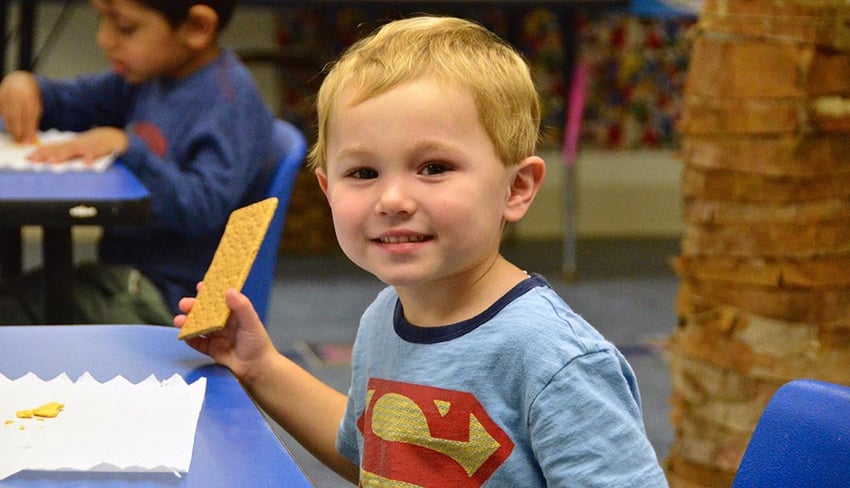
You want the best for your child—so what should you be looking for when you visit a nursery school? So much goes into a family’s final decision: Teachers, program, facilities, transportation, and cost, just to name a few.
Barring extraordinary circumstances, no parent would pick a school without visiting. It is important to have a sense of what is important before you visit, and to make sure you ask a consistent set of questions and make a consistent set of observations.
To help you best evaluate nurseries when you visit, we’ve compiled the list below for you to use when you are choosing a nursery program for your child.
Ready to take the next step? Come visit Friends' Central to see what we're all about!
1. How do the teachers interact with the children?
Observe the Nursery classrooms in action on your visit. Try to spend a few minutes in each room rather than just peeking in.
Are the teachers kind, understanding, and patient, as you would expect of an adult working with young children, or are they gruff and impatient? While it’s true that everyone has a bad day from time to time, it is the responsibility of the teachers to ensure that the nursery is a warm and encouraging environment. If this is not the way it appears, you should address this with the school director.
If the nursery program includes activities and academics and you are able to observe a session on your visit, watch to see how they are conducted. Does the teacher have command of the class without raising their voice? Are the teacher’s expectations clear? Is the teacher sitting at the same level as the children? If a child acts out, how is the teacher correcting the child? How is the teacher redirecting children who stray from the activity?
Though there is no “wrong” way of teaching, young children very often need more guidance than older children. You know how much guidance your child will need to be successful, and should be able to pretty accurately judge whether or not they would receive it at the nursery you are visiting.
2. How do the children engage with the teacher and the lessons?
Just as you watch to see how the teachers interact with the children, you should pay attention to how the children interact with the teachers.
When the teacher approaches, does the child appear happy and secure? This is an important and often subtle clue that can help you evaluate the classroom dynamic. Do the children gravitate toward the teacher, as opposed to away from the teacher?
Beyond this, how do the children interact with the lessons and creative play offered by the nursery program? Are they engaged, interested, and happy, or do they appear disinterested and bored? Your child will spend hundreds of hours at school, and you want them to be happy and engaged hours!
3. How do the children interact with one another?
One of the greatest benefits of enrolling your child in a nursery or preschool is that it allows them to build social skills before they enroll in a traditional school setting.
In addition to helping make that future transition easier for both you and your children, a good nursery program will help children become more confident and learn social skills that will make it easier for them to create lasting friendships in the future.
For this reason, it’s important that a nursery or preschool offers an inclusive, playful environment. Children should be encouraged to play together and make friends, to begin learning how to resolve conflicts in a healthy and productive way, and to begin the process of growing out of toddler behavior and into school-ready behavior.
You can get a sense of this by observing how the children interact with each other during an activity.
4. What is the teacher-to-child ratio?
Teacher-to-child ratio is often a top consideration for parents evaluating schools for their children, but it is especially critical to note when evaluating nursery programs, for a number of reasons.
The first, of course, is safety. Realistically, there are only so many young children that a person can and should attempt to care for. Because of the individual attention it takes to ensure that the children are out of harm’s way, it is important that the nursery staff is not responsible for too many children.
Beyond this, though, is the fact that nursery programs are more than simple daycare programs. The best nurseries are laying the groundwork for preschool and higher grades by teaching children important academic and social lessons. Because young children often need one-on-one attention to teach new skills and lessons, the effectiveness of these lessons is inevitably going to decrease when teachers tend to more children.
Teacher-to-child ratios are so important that there are often laws guiding them. In Pennsylvania, for example, these ratios vary by the age of the child:
- For infants (under one year old), the ratio is one faculty member for every four children, up to a max of eight children
- For young toddlers (one- to two-year-olds), the ratio is one faculty member for every five children, up to a maximum of ten children
- For older toddlers (two- to three-year-olds), the ratio is one faculty member for every six children, up to a maximum of 12 children
5. What are the health and safety protocols?
As a parent, the safety of your child is likely to be top of mind at all times, especially when you are entrusting your child to the care of someone else. That’s why it is important for you to be confident that any nursery program you are seriously considering for your child be a safe environment.
When you are visiting nursery facilities, in addition to asking questions about how the school handles issues of access, illness, allergies, emergencies, etc., you should ask questions and make observations during your visit and get a sense of how the school handles safety.
Are the classrooms “baby-proofed” with outlet covers and edge-softeners? Are cleaning supplies kept out of reach under lock and key? What kinds of toys are available for the children; small pieces can pose a choking hazard, and hard toys with sharp edges can be dangerous for young children and infants. When the children snack, are they sitting at a table? Are the teachers trained to manage unexpected allergic reactions or choking? Is there a nurse on staff?
Most importantly, nursery staff should have easy access to a first aid kit and fire extinguisher in the case of an emergency. Ask the staff where these supplies are located so that you can have some peace of mind.
Ensuring a Good Fit
After visiting and touring the nursery or preschools that you are considering for your child, you should walk away with a clear understanding of whether or not it would be a good fit for your child. Do you think that your child would be happy at the school in question? Do you think that they would be supported, and that they would make friends and learn new skills?
If not, you should continue your search. You’ll know a good fit when you find one.



